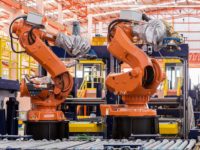Hexagon's annual HxGN LIVE international conference, held June 13-16, 2017 at The Venetian in Las Vegas, showcased the global precision measurement company's newest technologies and offered a vision for the future described as "limitless." The event was packed with inspiring keynotes, educational sessions, technology demos on the Zone floor and networking parties for its more than 3,000 attendees, most of whom were Hexagon customers and partners.
The conference ran on six custom tracks: Manufacturing Intelligence (MI), Geospatial, Geosystems, Safety & Infrastructure, Mining and PPM. The Zone floor was organized by track, as were the sessions and keynotes, save for the opening keynote from Hexagon president and CEO Ola Rollén on Tuesday that attendees from all tracks attended.
In his keynote, Rollén discussed Moore's Law, an observation made by Intel co-founder Gordon Moore in 1965 that the number of transistors per square inch on integrated circuits had doubled every year since their invention. Moore's law suggests exponential growth, that computers and computing power will become smaller and faster with time. Physical limitations are inevitable, however, which means that memory-driven computing is the next frontier. "It's going to blow Moore's Law out of the water," Rollén said.
He also talked about how we should transition from thinking about data as being "in the cloud" to "on the edge." He said that we must teach our computers how to learn as humans do, since the fastest computer is still 20 times slower than the human brain. That means putting information into data, Rollén said, and surpassing the limit of computational problem-solving by making our systems intuitive. We also can overcome the limit of perception, Rollén added, by "enhancing the unseen" through cutting-edge simulation software and virtual reality (VR) techniques.
The factory of the future
At the MI keynote on Wednesday, Norbert Hanke, CEO of Hexagon MI, announced that Hexagon will invest millions in a smart factory in Hongdao, China, set for completion in 2020.
Hanke also invited Dominic Gallello of MSC Software, recently acquired by Hexagon, and Doug Duchardt of Hendrick Motorsports to the stage to talk about how Hexagon helps them. Gallello described how his company combines Hexagon’s sensing technology with MSC’s simulation software to create a “neural network” for testing autonomous vehicles, while Duchardt explained how Hendrick uses Hexagon products, like ROMER arms, to build engines and continuously improve the company's racing vehicles for NASCAR.
Factories can be data-driven ecosystems, Hanke said, as long as you have a strong system for virtually integrating data, combing "real work" with "virtual work," and machines that are constantly learning and improving.
"Robots are highly efficient and repeatable, but they're not actually that accurate," Hanke said. "Continuous improvement drove the first Industrial Revolution, and so we must continue this."
New products
I followed the MI track at the show, which focused on “smart quality” solutions and connected shop floors. During a media tour of the MI section of the Zone, I saw several new MI products in action, primarily software (Metrology, CAD/CAM, Design & Costing) but also new laser tracking systems, 3D optical scanners and the recently launched “Global S” CMM.
Also new at the show this year was HxGN SMART Quality, an online quality lifecycle management software platform that harnesses the quality data stream across multiple phases of manufacturing. The software provides comprehensive statistical analysis, visualization and workflow management and enables real-time process improvements with "on the edge" data that is easily accessible in a clean and intuitive interface.
The year in review
On Thursday, I interviewed Angus Taylor, president and CEO of Hexagon MI North America, Ken Woodbine, president of Hexagon's metrology software product line and Hanke about the partnerships, acquisitions and other major steps forward that Hexagon MI has made over the past year.
Besides his confidence in the new smart factory, Hanke expressed enthusiasm for the "information automation" age in which Hexagon is now playing a major role. He said that the reason Hexagon bought the statistical process control software company Q-Das two and a half years ago was to gain their strength in advanced analytics; and with Q-Das' help in creating HxGN SMART Quality last year, they've made great progress.
When it comes to self-driving cars, however, Hanke and Taylor agree that it may be another 10 or 20 years until we see them on the roads en masse. "I don't think we're there yet," Hanke said. "It's still too dangerous." But they're working on it.
"The way you make a vehicle might have to change; certain colors might not be used because the car won't be able to see them as accurately," Taylor said. "But one thing that's good about MSC is that they have a lot of simulation tools to go through activities like these. And for Hexagon, when we acquired MSC, it was a natural fit: to be involved early in the process, when a vehicle is being designed."
Taylor also pointed to the acquisiton of the CAD/CAM software company VERO as a beneficial move for Hexagon MI.
"We transferred from being Hexagon Metrology to Hexagon Manufacturing Intelligence [so that] we could open up our portfolio and broaden the scope of how we are able to connect in manufacturing," Taylor said. "We are now starting to apply different levels of measurement to customers who were not necessarily using the same measurement tasks before; like in the die and mold area, we have products inside the VERO group that can improve the time to market for a die for an automotive vehicle, and that's the same for whether the car is gas-powered or electric or autonomous."
Woodbine said after implenting a "digital thread" at Hexagon that connects several departments, he has seen improvements internally, in terms of workforce morale and productivity, in addition to improvements in the products themselves.
"The digital thread for Hexagon is all about finding synergies between all the activities, and we always have a vision for them," Woodbine said. "When we make an acquisition, it's not just to plug in and stand alone, but to be part of the bigger whole."
The road forward
Also on Thursday, Rollén hosted a media luncheon at Delmonico's Steakhouse, where he fielded questions from a room full of journalists for about an hour.
First off, Rollén noted that while Hexagon’s exponential growth over the past decade has been “50 percent organic and 50 percent from acquisitions,” his goal is to move away from acquisitions to more organic growth and initiatives in the future. Additionally, he stressed the importance of collecting “actionable information” from data and creating a “closed feedback loop” with Hexagon’s digital thread of connected processes, as opposed to the silos of the past.
Rollén also touched on globalization, and how he believes it is global labor arbitrage that is taking manufacturing jobs away from Westerners, not automation. And in regard to the widening manufacturing skills gap, Rollén said one step we can take is to simplify interfaces to be as “intuitive as iPhones,” so that we can get “cheap metrologists” to work alongside the experts who handle the programming. Although many traditional manufacturing jobs will continue to dissapear in Industry 4.0 and beyond, Rollén said, many more jobs will be created for the unskilled that don’t currently exist.
"Stay positive," he said. "Stay limitless."
HxGN LIVE returns to Las Vegas June 12-15, 2018.




